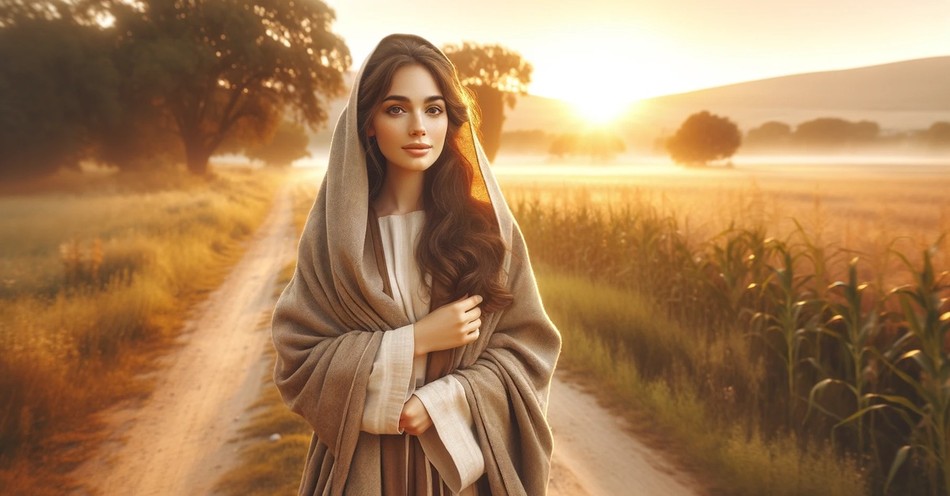The story of Ruth in the Bible isn’t just about a girl who was from Moab who landed in the genealogy of Jesus. It isn’t just the story of a foreigner who clung to an Israelite widow and found redemption.
The story of Ruth in the Bible is deep and wide and goes beyond who she was as a person. Yet that doesn’t negate the woman Ruth at all.
Hidden within the choices Ruth made, as well as her sister-in-law Orpah’s, is the breadth and depth of the story. Let's take a look at the entirety of Ruth's story and how God was with her each step of the way.
Quick Facts about Ruth
- Ruth was a Moabite woman and the daughter-in-law of Naomi
- She was married to Mahlon, the son of Naomi and Elimelech
- After her husband’s death, she chose to stay with Naomi, saying, "Where you go, I will go; your people will be my people, and your God my God." (Ruth 1:16)
- She traveled with Naomi to Bethlehem, leaving behind her homeland
- To provide for Naomi, she gleaned grain in the fields of Boaz, a wealthy relative of Elimelech
- Boaz noticed her loyalty and kindness and later redeemed her as a kinsman-redeemer, marrying her
- Ruth became the great-grandmother of King David, making her an ancestor of Jesus Christ (Matthew 1:5)
Origin of Ruth
Ruth and Orpah were daughters of Eglon and Balak, kings of Moab. The Moabites were the descendants of Lot and his eldest daughter (Genesis 19:37) following the destruction of Sodom and Gomorrah.
The Moabites didn’t serve God and were the enemies of the children of Israel.
The Bible Story of Ruth
This is the biblical account of how Ruth came to meet her first husband.
In the days when the judges ruled, there was a famine in the land. So a man from Bethlehem in Judah, together with his wife and two sons, went to live for a while in the country of Moab. The man’s name was Elimelek, his wife’s name was Naomi, and the names of his two sons were Mahlon and Kilion. They were Ephrathites from Bethlehem, Judah. And they went to Moab and lived there (Ruth 1:1-2).
After moving to Moab, Elimelek dies leaving Naomi and her sons alone. The sons marry Moabite women, Ruth and Orpah, instead of going back to Israel to find wives. Neither of them has any children. After living there for about 10 years, both of Naomi’s sons die as well.
After the death of her sons, Naomi heard that God had provided food for his people and she prepared to return home. There’s no record of either sister converting to Judaism upon marriage so when Naomi sets off for home, she tells them to return to their homes.
Naomi said to her two daughters-in-law, “Go back, each of you, to your mother’s home. May the Lord show you kindness, as you have shown kindness to your dead husbands and to me. May the Lord grant that each of you will find rest in the home of another husband” (Ruth 1:8-9).
Naomi kissed them goodbye, a ritual of breathing into them something of her own spirit.* At first, they both replied, “We will go back with you to your people” (Ruth 1:10).
But Naomi urged them to stay explaining how she couldn’t provide them with new husbands and children.
Ruth's Choice to Follow Naomi
After Naomi urges them to return to their home, the women make different choices. Orpah kisses her mother-in-law goodbye, returning Naomi’s breath to her, making her choice clear.*
But Ruth wouldn’t let go.
Naomi urges Ruth again saying, “Your sister-in-law is going back to her people and her gods. Go back with her” (Ruth 1:15).
Ruth chooses covenant with these words.
“Don’t urge me to leave you or to turn back from you. Where you go I will go, and where you stay I will stay. Your people will be my people and your God my God. Where you die I will die, and there I will be buried. May the Lord deal with me, be it ever so severely, if even death separates you and me” (Ruth 1:16-17).
Choices lead us in a direction.
Orpah’s choice to leave Naomi and Ruth was followed by her becoming the mother of an enemy of Israel.
According to the Talmud (Sotah 42b), “Upon leaving Naomi, Orpah ran into a battalion of 100 soldiers. She willingly submitted herself to them all. From the lot of them, she became pregnant and bore the giant Goliath, whom the young David would later meet in battle.”
Ruth’s choice to stay with and serve Naomi was followed by a much more honorable story.
Ruth and Naomi
Ruth loved her mother-in-law and humbled herself to serve and care for her. Upon arriving in Bethlehem, Naomi knew what to do for them to survive.
There were Jewish customs set up for widows and Naomi instructed Ruth. One custom was called gleaning. Farmers were to leave food on the ground as they harvested the grain so the poor could pick it up to feed their families.
Ruth followed her directions and went out to glean. While gleaning in a certain field, the landowner took notice of her. After learning who she was and her loyalty to Naomi, he responded to her with favor.
“I’ve been told all about what you have done for your mother-in-law since the death of your husband — how you left your father and mother and your homeland and came to live with a people you did not know before. May the LORD repay you for what you have done. May you be richly rewarded by the LORD, the God of Israel, under whose wings you have come to take refuge" (Ruth 2:11-12).
After this, he not only ensured her safety as she gleaned, but also made provision for her to take home an abundance.
Ruth and Boaz
Just as Jewish customs provided the way for Ruth and Naomi to feed themselves, there was a pathway for redemption as well.
The pathway to redemption unveiled in the Book of Ruth is twofold. It’s natural, in the case with Ruth, and spiritual, as it paints a picture of our Lord Jesus Christ.
This pathway to redemption was called a “kinsman-redeemer,” or “guardian-redeemer.” This was a male relative (next of kin) who was permitted to act on behalf (be a guardian) of a relative in danger or need.
When a woman became a widow with no children, it was this man’s right and responsibility to take action. He was to purchase everything that belonged to the dead husband, care for the widow, and father a son who would become the heir.
The landowner, who took notice of Ruth was a close male relative. His name was Boaz. When Naomi discovered this truth, she instructed Ruth to approach him according to this custom. Following Naomi’s instructions precisely, when it was time, she spoke:
“I am your servant Ruth,” she said. “Spread the corner of your garment over me, since you are a guardian-redeemer of our family” (Ruth 3:9).
Boaz liked the idea. However, he knew of a closer male relative he would need to get permission from.
Boaz secured the required permission from the other man. Soon, he and Ruth married, and a son was born. This son was named Obed, who was the father of Jesse, the father of King David who slew Goliath — the descendant of Orpah (as the Talmud depicts).
The women said to Naomi: “Praise be to the Lord, who this day has not left you without a guardian-redeemer. May he become famous throughout Israel! He will renew your life and sustain you in your old age. For your daughter-in-law, who loves you and who is better to you than seven sons, has given him birth” (Ruth 4:14-15).
Two women who knew such sorrow came into great joy. Ruth’s faithfulness to her mother-in-law and her newfound faith bore historic results. There are only five women listed in the genealogy of Jesus. Each one has a historic story and Ruth is one of them.
Ruth is evidence that your past and ethnicity don’t need to define you, but it’s your power of choice that can decide your destiny.
*As Ruth Rabbah to this verse points out, this kiss was not a mere expression of emotion but constituted a ritual. Naomi breathed into Orpah something of her own spirit that would accompany her in her sojourn among the idols of Moab. When Orpah did ultimately leave, she gave that kiss back for she no longer wanted Naomi or her God.
Lessons from the Story of Ruth
As we draw our exploration of Ruth to a close, let’s pause and reflect on the profound lessons her story offers us as believers. Ruth's journey is more than a tale of loyalty and love; it’s a vivid reminder of faith, resilience, and the beauty that unfolds when we trust in God's plan.
One of the most striking aspects of Ruth's story is her unwavering loyalty. In a world where commitments are often fleeting, Ruth’s dedication to Naomi stands as a beacon of steadfast love. “Where you go, I will go; where you stay, I will stay,” she declares, embodying the essence of true companionship and faithfulness. This challenges us to examine our own relationships—are we as committed and loyal to our loved ones as Ruth was to Naomi?
Ruth’s life also highlights the importance of taking bold steps of faith. Leaving her homeland and everything familiar, she ventured into the unknown, trusting in Naomi’s God. This leap of faith wasn’t easy, but it brought her to Boaz and ultimately placed her in the lineage of King David and Jesus. How often do we hold back, afraid to leave our comfort zones? Ruth’s courage encourages us to step out in faith, trusting that God’s plans for us are greater than we can imagine.
Lastly, and most important, Ruth’s story is a beautiful testament to God’s provision and redemption. Despite the hardship and loss she faced, God’s hand was at work, orchestrating events for her good and the good of others. It’s a powerful reminder that even in our darkest moments, God is with us, weaving a tapestry of grace and purpose. We can take heart in knowing that our struggles are not in vain; they are often the soil from which God’s greatest blessings grow.
As we look at Ruth’s life, we’re reminded that God’s love knows no boundaries. Ruth, a Moabite woman, became an integral part of God’s people and His redemptive plan. This inclusivity reassures us that no matter our background or past, we are cherished and have a place in God’s family. It calls us to extend that same grace and acceptance to others, embracing the diversity within our own communities.
In conclusion, Ruth’s story isn’t just an ancient narrative; it’s a timeless message of hope, faith, and love. It challenges us to be loyal, to take courageous steps of faith, and to trust in God’s providence. As we live out these lessons in our daily lives, we too can become part of a beautiful story of redemption and grace, reflecting the love of God in a world that desperately needs it. So, let’s carry Ruth’s legacy forward, letting her story inspire us to live with greater faith, love, and hope.
For further reading:
Ruth vs. Orpah: The High Stakes of Life
The Fall of the House of Orpah
Photo Credit edited and created using Dalle AI
Danielle Bernock is an international, award-winning author, coach, and speaker who helps people embrace their value and heal their souls through the power of the love of God. She’s written Emerging With Wings, A Bird Named Payn, Love’s Manifesto, Because You Matter, and hosts the Victorious Souls Podcast. A long-time follower of Christ, Danielle lives with her husband in Michigan near her adult children and grandchildren. For more information or to connect with Danielle https://www.daniellebernock.com/



